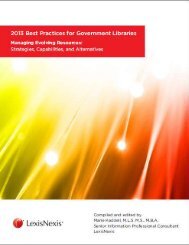2012 Best Practices for Government Libraries
2012 Best Practices for Government Libraries
2012 Best Practices for Government Libraries
You also want an ePaper? Increase the reach of your titles
YUMPU automatically turns print PDFs into web optimized ePapers that Google loves.
Bibliography Boon: A Knowledge Initiative<br />
220<br />
BEST PRACTICES <strong>2012</strong><br />
By Leanna E. Bush, Library Technician, US Army Medical Research Institute of<br />
Chemical Defense, Wood Technical Library, Aberdeen Proving Ground, MD<br />
I’m updating my CV but don’t remember all of my publications. How do I get<br />
that in<strong>for</strong>mation? I have a new student and would like him or her to read my<br />
articles from the last couple of year. Where do I find copies?<br />
If you work in a research library, you too have probably been asked similar<br />
questions from patrons overwhelmed by the prospect of having to obtain their<br />
career publications. Federal research libraries also have the unique requirement of<br />
depositing publications with the Defense Technical In<strong>for</strong>mation Center (DTIC). In<br />
an ef<strong>for</strong>t to address these two issues, library staff at the Wood Technical Library<br />
launched a comprehensive bibliographic project that, to date, contains over 3,900<br />
citations.<br />
The process of creating the bibliography was simple but time consuming.<br />
Fortunately, our editorial staff had already compiled a record of journal articles and<br />
technical reports, so that was our starting point. Library staff per<strong>for</strong>med exhaustive<br />
searches in a variety of databases (e.g., PubMed, Web of Knowledge, etc.) to<br />
augment this list. As items were identified, staff manually added each citation to<br />
EndNote® bibliographic management software. The flexibility of this product<br />
permitted a wide array of documents to be cataloged by type and enabled quick<br />
retrieval of similar items. Basic templates were customized to display selected<br />
in<strong>for</strong>mation about each citation so that any end user could quickly retrieve and<br />
display the pertinent in<strong>for</strong>mation <strong>for</strong> his or her publications. The “Cite While You<br />
Write” feature <strong>for</strong> Microsoft Word also made it very easy to cite references, figures,<br />
and tables in the proper <strong>for</strong>mat.<br />
With EndNote®, library staff had the capability to add a wealth of in<strong>for</strong>mation to a<br />
citation. DTIC accession numbers were incorporated into records so that deposited<br />
items were readily identified. Abstracts and keywords were also included in each<br />
record so that searches were more accurate. With the inclusion of this in<strong>for</strong>mation,<br />
there was no longer the need to know the exact title or author since free text key<br />
word searching was an option. For those articles deposited in DTIC or made freely<br />
available by publishers, the URL was also added to the citation record.<br />
Using the share feature in EndNote®, all library patrons may download and use the<br />
historical bibliography. Patrons may re<strong>for</strong>mat the bibliography by customizing<br />
templates so that it becomes a CV on the spot. Since the bibliography will be<br />
updated and automatically <strong>for</strong>matted, patrons no longer have to waste valuable<br />
time with the upkeep of their own publications. Library staff also save tedious<br />
hours in searching various databases to respond to requests <strong>for</strong> in-house<br />
publication in<strong>for</strong>mation.



